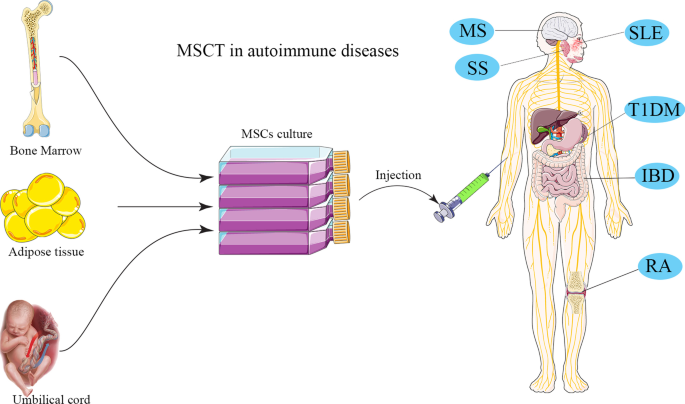Regenerative Medicine For Multiple Sclerosis Fundamentals Explained
Wiki Article
Fascination About Regenerative Medicine For Multiple Sclerosis
Table of ContentsExcitement About Regenerative Medicine For Multiple SclerosisFascination About Regenerative Medicine For Multiple SclerosisUnknown Facts About Regenerative Medicine For Multiple SclerosisRegenerative Medicine For Multiple Sclerosis Things To Know Before You Get ThisThe 8-Minute Rule for Regenerative Medicine For Multiple SclerosisNot known Facts About Regenerative Medicine For Multiple SclerosisThe Facts About Regenerative Medicine For Multiple Sclerosis Uncovered
The mesenchymal stem cells hair transplanted during stem cell treatment can divide and mature to develop brand-new cells that can replace the harmed cells of the worried tissue. This could restore neurological functions in people with this problem. These advantages of stem cell treatment are further sustained by the ability of MSCs to advertise recovery.People with several sclerosis are usually treated with mesenchymal stem cells. These are multipotent stem cells that have the capability to differentiate and grow to develop a variety of cell types in the body. When hair transplanted, these stem cells can develop to develop healthy nerve cells hence supporting the regeneration of the damaged tissues of the nervous system.
As soon as transplanted, the stem cells move to areas of inflammation or damage within the central nerve system (CNS). They are normally brought in to the sites of injury where the immune system is assaulting the myelin sheath, the protective treatment of nerve fibers. The stem cells work by promoting the repair service and regrowth of damaged myelin, possibly bring back function to impacted afferent neuron.
The Ultimate Guide To Regenerative Medicine For Multiple Sclerosis
Stem Cell Research Study on MS The National Numerous Sclerosis Culture, along with various other organizations, is actively funding and supporting research right into mesenchymal stem cell therapy for multiple sclerosis to explore their possible and boost treatment procedures. The goal is to establish safer and a lot more reliable methods to utilize stem cells in dealing with MS.
The Best Strategy To Use For Regenerative Medicine For Multiple Sclerosis
Here are reviews from patients of the Swiss Medica clinic. The client took a trip from Romania seeking treatment for MS after listening to positive responses regarding stem cell therapy for the illness.Obtain a cost-free online assessment to find out just how stem cells will help your situation, and what are the period and price of the treatment. Medical Expert, Swiss Medica physician Lemus, H. N., Warrington, A. E., & Rodriguez, M. (2018 ). Multiple Sclerosis: Mechanisms of Disease and Methods for Myelin and Axonal Repair.
An Unbiased View of Regenerative Medicine For Multiple Sclerosis

Stem cells are cells in the body that can mature into specialized cells that serve a specific feature. They are additionally able to produce exact copies of themselves. There are two main kinds of stem cells: beginning stem cells and grown-up stem cells. are discovered in the creating embryo and can mature right into most sorts of cells in the body.
are found in some grown-up tissues and organs including the bone marrow, skin, blood, and mind. Grown-up stem cells are not as adaptable as embryonic stem cells and are consequently more limited in terms of the kinds of cells they mature right into. The unique properties of stem cells offer guarantee for brand-new therapies that can slow/halt MS illness task and repair cells damage in the central nerve system.
Some Known Incorrect Statements About Regenerative Medicine For Multiple Sclerosis

The procedure involves collecting stem cells from a person's own (autologous) bone marrow. The person is then treated with chemotherapy to diminish the immune system and stem cells are reestablished into the body where they grow into brand-new, healthy immune cells - Regenerative Medicine for Multiple Sclerosis. Stem cells can be injected right into the body in various means

In 2000, the MS Society of Canada and MS Scientific Research Foundation funded a scientific trial entailing HSC transplants, led by Drs. Mark Freedman and Harry Atkins from the Ottawa Hospital Study Institute/University of Ottawa. The aHSC therapy readily available in Canada is a therapy that utilizes high-dose chemotherapy, also called conditioning.
Website

Top Guidelines Of Regenerative Medicine For Multiple Sclerosis
Neural stem cells (NSC) are discovered in the mind and can develop right into various kinds of mind cells including nerve cells, oligodendrocytes, and astrocytes. NSCs might serve to repair or secure the mind and modulate the body immune system. Early professional tests in non-human primates demonstrated that treatment with NSCs benefitted the development of MS-like disease in pet versions.The results from these safety researches are positive for future stem cell and regenerative medication treatments in MS. Future scientific tests (stage 2 and 3) with bigger varieties of participants and controls are needed to examine the efficacy of this treatment for MS. As demonstrated by the examples above, there is a vast variety of study occurring that will certainly offer added answers about using stem cells to look at this web-site deal with MS.
Stem cell treatment is thought about secure, but, like any kind of medical procedure, it brings some risks, such as temporary swelling or discomfort at the shot website. Nonetheless, serious adverse effects are uncommon when carried out by certified specialists.
The 25-Second Trick For Regenerative Medicine For Multiple Sclerosis
Multiple sclerosis (MS) is a persistent disease of the central nerves that affects see post the mind and spinal cable. It is identified by the degradation of myelin, a compound that covers nerve fibers, resulting in disruptions in communication in between the mind and the remainder of the body. Symptoms can vary extensively and include muscle weak point, vision issues, discrepancy, and fatigue.Numerous sclerosis is identified by the body immune system incorrectly striking the protective sheath (myelin) that covers nerve fibers, triggering interaction issues between the brain et cetera of the body. The condition can result in the deterioration or irreversible damages of nerves. Signs vary commonly among people and can include tiredness, movement problems, pain, and cognitive modifications.
Report this wiki page